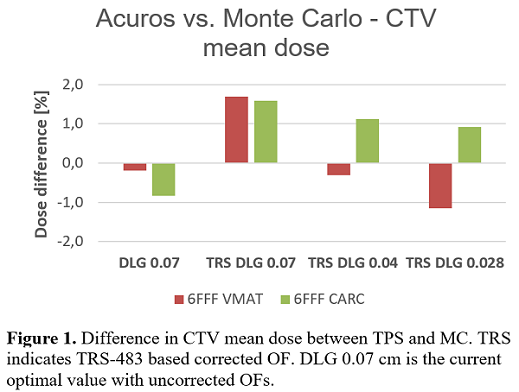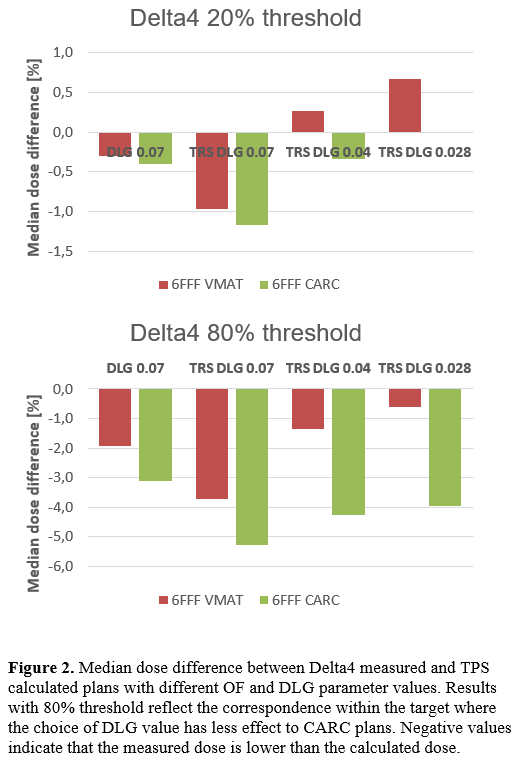The effect of TRS-483 recommendations on dose calculation accuracy of stereotactic treatment plans
PO-1567
Abstract
The effect of TRS-483 recommendations on dose calculation accuracy of stereotactic treatment plans
Authors: Antti Vanhanen1, Mari Partanen1, Jarkko Ojala1
1Tampere University Hospital, Oncology/Medical Physics, Tampere, Finland
Show Affiliations
Hide Affiliations
Purpose or Objective
Output factor (OF)
corrections based on IAEA TRS-483 Code of Practice (TRS-483) may be several
percent for certain detector and beam types and sizes, and the implementation
of the corrections may cause the need to adjust other parameters affecting the calculated
dose distributions. The aim of this study was to evaluate the effect of TRS-483
based OF corrections on dose calculation accuracy of 6 MV FFF VMAT and
conformal arc (CARC) stereotactic treatment plans of small lesions.
Material and Methods
Nine treatment plans (6 VMAT, 3 CARC) were re-calculated using corrected
OFs and varying values for dosimetric leaf gap (DLG). A TrueBeam STx linear
accelerator equipped with high-definition MLC, and configured in Varian Eclipse
treatment planning system (TPS) (version 15.6) (Varian Medical Systems Inc,
Palo Alto, CA), was used for the dose calculation. Effective target spot size
(SS) was 1.5 and 0.0 mm in X and Y directions, respectively. Objects covered three
brain (planning target volumes (PTVs) of 0.5-1.7 cc) and three lung targets (PTVs
of 5.2-30.0 cc). The plans were calculated using Acuros XB dose calculation
algorithm (version 15.6.04). TPS dose distributions were compared to EGSnrc-based
full Monte Carlo (MC) simulations and measurements using Delta4 phantom (ScandiDos,
Uppsala, Sweden).
Results
Difference in clinical target volume (CTV) mean dose between TPS and MC for VMAT and CARC plans and different OF and DLG
values are presented in fig 1. Median dose difference between measured and TPS
calculated plans are shown in fig 2. Compared to MC simulations and
measurements, TRS-483 based OF correction seems to overestimate the resulting
dose, which is seen especially in CARC plans, for which the adjustment of DLG
does not fully compensate for the increased output.


Conclusion
Implementation of TRS-483 based OF corrections without adjusting the DLG
may cause notable changes in dose calculation accuracy. Differences between
VMAT and CARC plans require further investigation of the accuracy of the OFs
and optimal DLG and SS values. Overall, the implementation of TRS-483 based OF
corrections should be verified with utmost care.